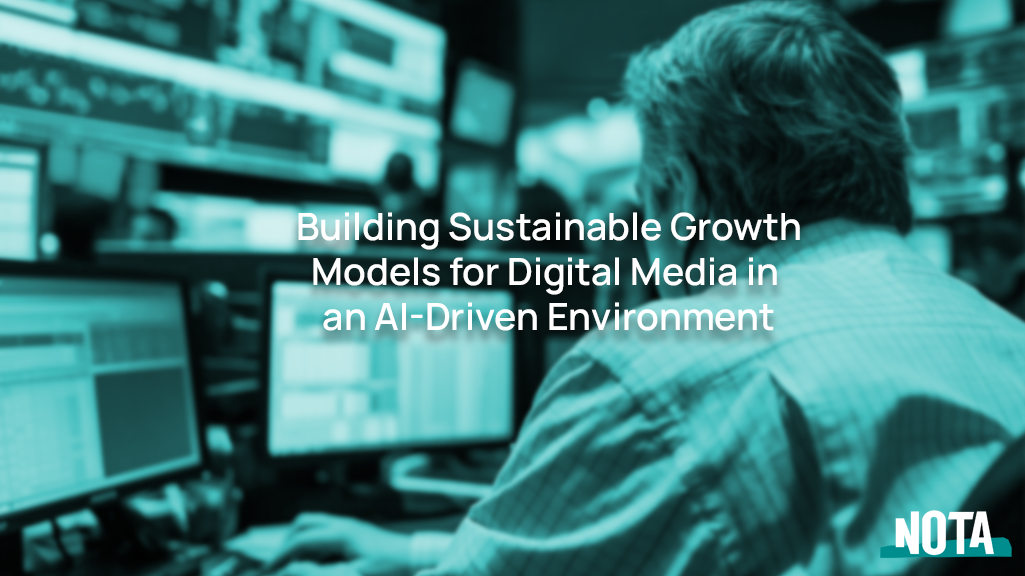In the age of AI, media companies face a delicate balancing act. Generative AI (Gen AI) has the potential to revolutionize journalism, but its implementation raises crucial questions about transparency, trust and ethical use. For AI to enhance rather than undermine public trust, media organizations must commit to self-regulation and ethical standards that prioritize these values.
Nota champions the idea that AI should assist – not replace – human storytelling. By automating routine tasks, analyzing vast datasets and enhancing content creation, AI can support journalists in producing high-quality content while saving precious time for them to focus on what they do best – telling stories and reporting the news.
Here are a few of the steps Nota took to ensure our products and organization adhere to the highest self-regulatory guidelines; we challenge and encourage other AI technology companies to do the same.
Tech Accord to Combat Deceptive Use of AI in 2024 Elections
As a signatory to the Tech Accord to Combat Deceptive Use of AI in 2024 Elections, Nota is actively demonstrating our commitment to the ethical use of AI in journalism. The Accord, supported by market leaders like Adobe, Amazon and Google, aims to combat deceptive AI content during election cycles. Key principles include:
- Developing mitigation technologies to identify and certify authentic content
- Fostering industry collaboration to share best practices
- Promoting public awareness and media literacy
The Coalition for Content Provenance and Authenticity
Nota also integrated C2PA standards within our tools, ensuring content provenance and authenticity. The Coalition for Content Provenance and Authenticity (C2PA) addresses misinformation by certifying the source and history of media content, enhancing trust in the visual record. Formed by Adobe, Microsoft and other leading technology companies, C2PA establishes technical standards for certifying media content provenance, helping creators track and disclose AI use while maintaining transparency.
By incorporating C2PA standards, Nota’s tools provide verifiable information about the origin and history of digital content, which is crucial for maintaining the credibility and trustworthiness of AI-generated media.
Alignment with the European Union AI Act
Additionally, Nota aligns with the European Union AI Act’s principles, emphasizing trustworthy AI. The AI Act sets clear requirements for AI systems, aiming to ensure safety, transparency and ethical use. These requirements are particularly critical in journalism, where AI tools must uphold the integrity of content.
The AI Act includes provisions that mandate high standards for data quality, transparency in AI operations, and accountability for AI outputs. By adhering to these principles, Nota ensures its AI applications meet the stringent requirements necessary to protect public trust and ethical standards in AI use.
Formulation of AI Advisory Boards
Beyond regulatory compliance, proactive self-regulation is vital. AI companies should establish editorial boards to develop and audit their solutions, ensuring they meet ethical standards and promote a responsible approach to AI integration. Nota will soon announce the formation of our own Editorial AI Board to ensure Nota’s AI tools are informed by diverse perspectives and decades of global newsroom experience, reflecting the highest standards of journalistic integrity.
Proactive self-regulation involves continuous monitoring and evaluation of AI systems, creating guidelines for ethical AI use and ensuring AI outputs are consistently reviewed for accuracy and bias. This is the only way we can confidently maintain the highest ethical standards and foster public trust in AI technologies.
As AI’s influence in journalism and visual communication expands, maintaining public trust is essential. By embracing ethical standards like C2PA and aligning with the AI Act, companies will ensure transparency and reliability in AI-assisted content creation. Proactive self-regulation further supports these efforts, fostering a future where AI complements, not replaces, ethical human storytelling.




